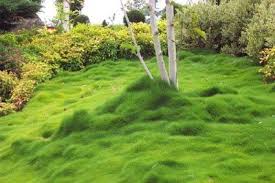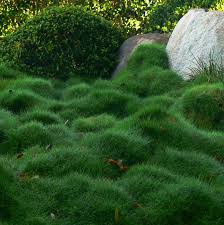Korean Grass, scientifically known as Zoysia japonica, is a type of grass that is commonly used for lawns and landscapes. It’s a hardy and versatile plant that has gained popularity for its durability and low maintenance requirements.
Zoysia japonica, or Korean Grass, is a warm-season grass that thrives in sunny areas. It’s often chosen for its ability to tolerate heat, drought, and foot traffic. This makes it an excellent choice for lawns in regions with hot and humid climates. Its deep green color and fine texture give lawns a lush and inviting appearance.
One of the remarkable features of Korean Grass is its slow growth rate. While this might not sound like a benefit, it means less frequent mowing is needed. This can be a time and effort saver for homeowners who prefer to spend less time maintaining their lawns. Additionally, the slow growth helps Korean Grass to outcompete weeds, keeping the lawn looking neat and healthy.
Another advantage of Zoysia japonica is its ability to establish a dense and thick turf. Once it takes root and spreads, it forms a natural barrier against weeds, preventing them from taking over the lawn. This characteristic is especially useful for those who want a well-manicured lawn without the hassle of constant weed removal.
While Korean Grass is resilient, it’s important to note that it does require some care to reach its full potential. Regular watering, especially during its establishment phase, is essential. Adequate water helps the grass develop strong roots and become better prepared to handle periods of drought. Fertilizing the lawn a couple of times a year can also promote healthy growth and vibrant color.
In addition, Zoysia japonica, commonly known as Korean Grass, is a reliable choice for lawns and landscapes. Its scientific name might sound complex, but its characteristics are straightforward, which signifies a tough grass that can handle heat, drought, and foot traffic. With its slow growth rate and ability to form a dense turf, Korean Grass makes lawn maintenance more manageable. Just remember to give it the care it needs to flourish, and you’ll be rewarded with a beautiful, resilient lawn.
Read Also: 10 Medicinal Health Benefits of Bidens pilosa (Spanish needle)
How to Grow and Care for Korean Grass

Growing and caring for Korean Grass (Zoysia japonica) involves a few important steps to ensure a lush and healthy lawn. Here’s a simple guide to help you get started:
1. Choose the Right Location: Korean Grass thrives in sunny areas, so select a spot in your yard that receives at least 6-8 hours of direct sunlight each day.
2. Soil Preparation: Prepare the soil by removing weeds, rocks, and debris. Loosen the soil using a garden fork or tiller to a depth of about 4-6 inches. This will help the grass establish strong roots.
3. Planting: Korean Grass is commonly grown from sod, plugs, or sprigs. Sod and plugs provide quicker results, while sprigs take longer to establish. Plant the sod, plugs, or sprigs according to the recommended spacing provided on the packaging.
4. Watering: Water the newly planted grass thoroughly immediately after planting. For the first few weeks, keep the soil consistently moist to aid in root establishment. Once the grass is established, gradually reduce the frequency of watering but water deeply to encourage deep root growth.
5. Mowing: Start mowing when the grass reaches a height of about 2-3 inches. Set your mower to a higher setting initially to avoid stressing the young grass. As the grass becomes more established, gradually lower the mowing height to your desired level. Avoid cutting more than one-third of the grass height at a time.
6. Fertilizing: Apply a balanced, slow-release fertilizer in the spring and again in early summer. Follow the manufacturer’s recommendations for application rates. Avoid over-fertilization, as it can lead to thatch buildup.
7. Weed Control: Korean Grass forms a dense turf that helps prevent weed growth. However, some weeds might still appear. Use a pre-emergent herbicide in early spring to prevent weed seeds from germinating. Spot-treat any weeds that manage to grow.
8. Aeration: Core aeration helps to reduce soil compaction and allows air, water, and nutrients to reach the grass roots. Consider aerating your lawn every couple of years, preferably in the early spring or fall.
9. Disease and Pest Control: Korean Grass is relatively resistant to many diseases and pests, but it’s still important to monitor for any signs of problems. Consult with a local gardening center if you notice any unusual changes in the grass’s appearance.
10. Winter Care: Korean Grass goes dormant during the winter in cooler climates. Provide a final fertilizer application in late fall to help the grass store nutrients for the winter months. Avoid walking on dormant grass to prevent damage.
Remember that patience is key when growing Korean Grass. It might take a season or two for the grass to become fully established and showcase its true potential. By following these care tips and providing consistent attention, you’ll be rewarded with a beautiful, resilient lawn that enhances your outdoor space.
Uses of Korean Grass

Korean Grass (Zoysia japonica) has several practical uses due to its characteristics and qualities. Here are some common applications:
1. Lawn Grass: One of the primary uses of Korean Grass is as a lawn grass. Its dense and fine-textured turf creates a lush and visually appealing lawn. It can withstand foot traffic and is suitable for both residential and commercial lawns.
2. Landscaping: Korean Grass is often used in landscaping projects. Its ability to form a uniform carpet-like ground cover makes it a popular choice for creating pathways, open spaces, and green spaces in parks, gardens, and public areas.
3. Golf Courses: Its durability and tolerance to foot traffic make Korean Grass a suitable option for golf course fairways and roughs. Golf courses can benefit from its resilience, as it can handle the wear and tear from golfers while maintaining an attractive appearance.
4. Erosion Control: Korean Grass has an extensive root system that helps prevent soil erosion. It’s commonly used on slopes and embankments to stabilize the soil and prevent runoff during heavy rains.
5. Sports Fields: Some sports fields, such as soccer fields and football fields, use Korean Grass for its ability to handle heavy use and recover quickly. Its dense growth and ability to withstand wear make it a practical choice for sports surfaces.
6. Recreational Areas: Parks, playgrounds, and recreational areas often utilize Korean Grass because of its durability and low maintenance requirements. Its ability to withstand play and foot traffic without becoming excessively damaged is a significant advantage.
7. Green Roofs: In urban areas, Korean Grass is sometimes used on green roofs due to its drought tolerance and low maintenance needs. It can help improve the energy efficiency of buildings while providing a visually appealing rooftop garden.
8. Soil Improvement: Korean Grass’s dense root system can help improve soil structure by preventing compaction and promoting water infiltration. As the grass decomposes, it adds organic matter to the soil, enhancing its fertility.
9. Economic Benefits: Using Korean Grass in various applications can contribute to economic benefits. Reduced maintenance costs, water conservation, and the ability to withstand heavy use can save money in the long run.
10. Aesthetic Enhancement: Whether in residential yards, commercial spaces, or public areas, Korean Grass adds to the aesthetic appeal of outdoor environments. Its vibrant green color and uniform growth contribute to a pleasing visual landscape.
Overall, the versatility and resilience of Korean Grass make it a valuable choice for a range of purposes, from creating beautiful lawns to stabilizing soil and enhancing recreational areas. Its ability to thrive in various conditions and its low maintenance requirements contribute to its popularity in different landscaping and outdoor projects.
Read Also: 10 Medicinal Health Benefits of Atractylodes Macrocephala (Bai Zhu)
Where to Find Korean Grass near Me/You

Here are three perfect places where you can commonly find or locate Korean Grass (Zoysia japonica):
1. Nurseries and Garden Centers: Nurseries and garden centers are excellent places to find Korean Grass. They often offer a variety of grass types, including sod, plugs, or seeds of Korean Grass. The staff at these locations can provide guidance on selecting the right type of Korean Grass for your specific needs and offer advice on how to care for it.
2. Landscaping Supply Stores: Many landscaping supply stores carry Korean Grass products for both residential and commercial projects. You can find sod rolls, plugs, or even specialized soil mixes designed to promote successful grass establishment. These stores might also provide information on proper installation and maintenance techniques.
3. Online Retailers and Seed Companies: If you prefer the convenience of online shopping, various online retailers and seed companies offer Korean Grass products. You can order sod, plugs, or seeds and have them delivered to your doorstep. Make sure to read reviews and choose reputable sellers to ensure you’re getting high-quality products.
Remember to consider your specific needs and the purpose of the Korean Grass (such as lawn, landscaping, or sports field) when selecting where to obtain it. Additionally, reach out to local gardening experts or agricultural extension offices for recommendations on the best sources for Korean Grass in your area.
Read Also: 5 Ways to Properly Dispose your Metal Wastes
